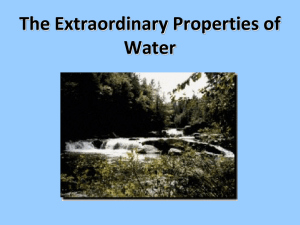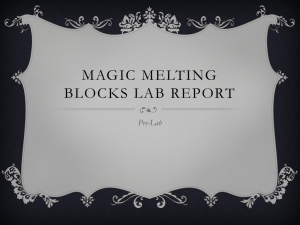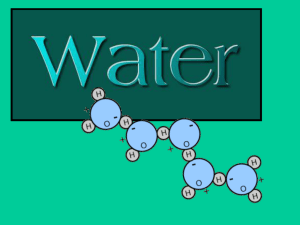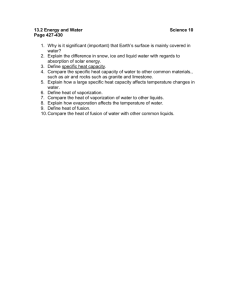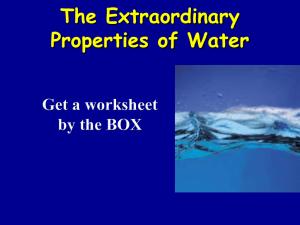Water
advertisement
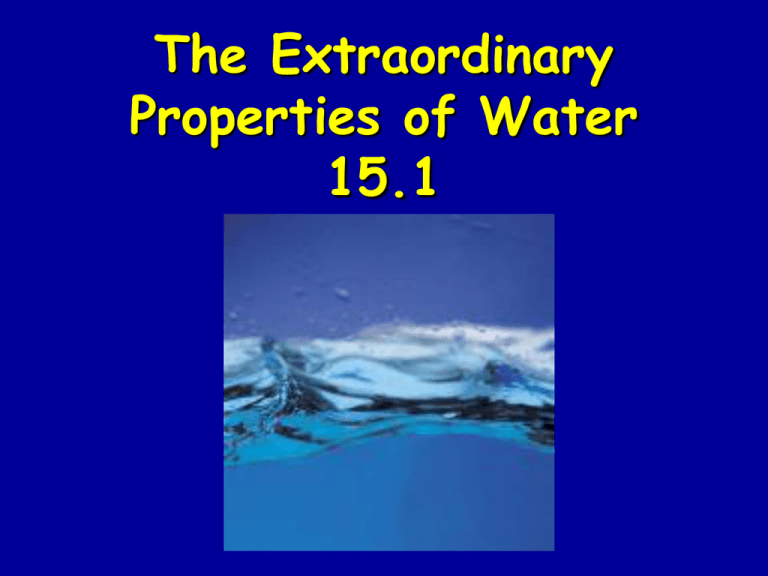
The Extraordinary Properties of Water 15.1 Objectives • Understand the polar nature of water • Be able to draw a hydrogen bond between two water molecules • Understand water’s special physical properties and why they are present Why Studying Water is Important • • • • • 75% of Earth is covered by water Humans are made mostly of water (62%) Almost all chemical rxns involved in life processes take place in water Humans need water to survive Water teaches a lot of important scientific concepts Water is Polar • In each water molecule, the oxygen atom attracts more than its "fair share" of electrons • The oxygen end “acts” negative • The hydrogen end “acts” positive • Causes the water to be POLAR Hydrogen Bonding in Water What are the Properties of Water? Properties of Water: Boiling Point • At sea level, pure water boils at 100 °C and freezes at 0 °C. • The boiling temperature of water decreases at higher elevations (lower atmospheric pressure). • For this reason, an egg will take longer to boil at higher altitudes Properties of Water • Cohesion • Adhesion • High Specific Heat • High Heat of Vaporization and Fusion (Melting) • Weird Density Profile Cohesion • Attraction between particles of the same substance ( why water is attracted to itself) • Results in Surface tension (a measure of the strength of water’s surface) • Produces a surface film on water that allows insects to walk on the surface of water Adhesion • Attraction between two different substances. • Capillary action-water molecules will “tow” each other along when in a thin glass tube. • Example: transpiration process which plants and trees remove water from the soil, and paper towels soak up water. Adhesion Causes Capillary Action Which gives water the ability to “climb” structures High Specific Heat • Amount of heat needed to raise or lower 1g of a substance 1° C. • Water resists temperature change, both for heating and cooling. • Water = 4.18 J/goC Chloroform = 0.54 J/goC Copper = 0.38 J/goC High Heat of Vaporization • Amount of energy to convert 1g of a substance from a liquid to a gas. (Water’s heat of vaporization is 540 cal/g) • In order for water to evaporate, hydrogen bonds must be broken. • This means water has a very low vapor pressure. It will take longer to evaporate than most other liquids. High Heat of Fusion • Water's heat of fusion is 80 cal/g • In order for ice to melt, each gram must GAIN 80 calories • Compare to chloroform 17.7 cal/g Which is ice and which is water? Water is Less Dense as a Solid Water (Liquid) Ice (Solid) Real World Examples: Ice Less Dense Than Water Soda cans explode in freezers Pipes burst in cold climates Potholes are worse in cold climates Breakdown of rocks seen in mountain streams (Erosion) • Maintains life in lakes (lakes don’t freeze from bottom up) • • • • Properties of Water • Cohesion • Adhesion • High Specific Heat • High Heat of Vaporization and Fusion (Melting) • Weird Density Profile Some Cool Water Videos Molecular Modeling of Ice Water Freezing Ice melting Modeling of Melting Ice Brownian Motion of Water Molecular Dynamics Simulator of Water

